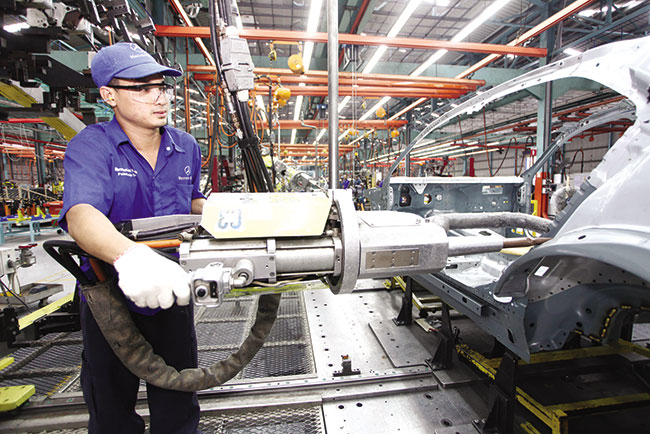German businesses setting up shop

Vietnam’s manufacturing sector is boosted by new German investment projects Photo: Le Toan
Siemens, Mercedes-Benz, and Bosch made the move after they realised the huge potential of the local market, where approximately 46 per cent of all Vietnamese machinery imports are from Germany.
One German company that has been present in Vietnam long-term is Siemens, which dates back to 1979, when the company supplied and installed the first two industrial steam turbines at the Bai Bang paper mill. The establishment of its representative office in 1993 and the shift to a limited company in 2002, as well as the inauguration of the Siemens Automation System plant in the southern province of Binh Duong in 2005, mark key developments and milestones in Siemens’ history in Vietnam. In particular, Siemens Vietnam was entrusted by Siemens AG to establish a hub with qualified staff to work in site management, construction, commissioning, environment, health and safety, and quality control for Siemens’ power plant projects in Asia and the Middle East.
Siemens Vietnam president and CEO Pham Thai Lai stated that the company had been on track for growth over the past five years. Last fiscal year, for example, the company achieved and surpassed many business targets, ending in an increase of 20 per cent in revenue and 200 per cent in net income against the previous fiscal year. For the last fiscal year, Lai expected a similar growth rate.
He is also very confident about the bright future of the busway factory in Binh Duong. Siemens is now the No.1 supplier of busway products on Vietnam’s market, and is exporting to more than 30 countries across the world, helping to ensure stable employment and income for hundreds of Vietnamese employees and workers.
In a similar move to Siemens, Robert Bosch Vietnam, a member of German Bosch Group, has had a presence in Vietnam since 1994 as a leading global supplier of technology and services through its representative offices. In August 2008, Robert Bosch Vietnam decided to start the continuously variable transmissions (CVT) push-belt production facility in the southern province of Dong Nai’s Long Thanh industrial park to meet the growing demands of the domestic market. In late 2013, the company invested an extra $208 million to increase the factory capacity, raising the total investment for Robert Bosch Vietnam’s plant to $340 million.
According to Vo Quang Hue, managing director of Robert Bosch Vietnam, thanks to proper investment strategies, in 2014, his firm made the total net revenue of $340 million, up 20 per cent from 2013. This was the sixth consecutive year that the group reported a double-digit growth rate in the market. Hue elaborated that Robert Bosch Vietnam would continue to increase investments in the hi-tech plant in Dong Nai by constructing a new workshop and setting up new production lines in order to increase the output capacity.
Meanwhile, Mercedes-Benz Vietnam, which was set up in 1995, put a new environmentally-friendly electrostatic paint factory into operation in 2013, with the investment capital of $10 million. In 2014, the car maker injected an additional $10 million for its new production line, expansion of the company’s agent network, as well as promotion for environmental protection.
In the pharmaceutical industry, B. Braun Melsungen, a pharmaceutical company which has over twenty years of experience in Vietnam and is widely considered a successful firm. In 2014, it reinvested $270 million into the facility in Vietnam, including a $66.3 million to establish a new factory.
As of August 20, 2015, German companies have invested in 259 projects in Vietnam with the total registered investment capital of $1.38 billion.
What the stars mean:
★ Poor ★ ★ Promising ★★★ Good ★★★★ Very good ★★★★★ Exceptional
 Tag:
Tag:
Related Contents
Latest News
More News
- Global partnerships key to Vietnam’s IFC development (December 26, 2025 | 16:18)
- Vingroup pulls out of bid to invest in North-South high-speed railway (December 26, 2025 | 11:42)
- Strengthening supply chains through trade promotions and customs reform (December 24, 2025 | 14:00)
- PM orders investment model for North–South high-speed rail (December 22, 2025 | 17:43)
- LS Eco Energy to invest in Vietnam rare earth sector (December 22, 2025 | 17:31)
- Government moves to establish International Financial Centre (December 21, 2025 | 21:00)
- Vietnam's IFC to target global investment flows (December 21, 2025 | 18:00)
- Two national hospitals expand capacity with new facilities (December 20, 2025 | 09:00)
- Ha Tinh breaks ground on major Vingroup industrial and energy projects (December 19, 2025 | 18:24)
- EVN launches major power infrastructure projects nationwide (December 19, 2025 | 18:17)






















 Mobile Version
Mobile Version